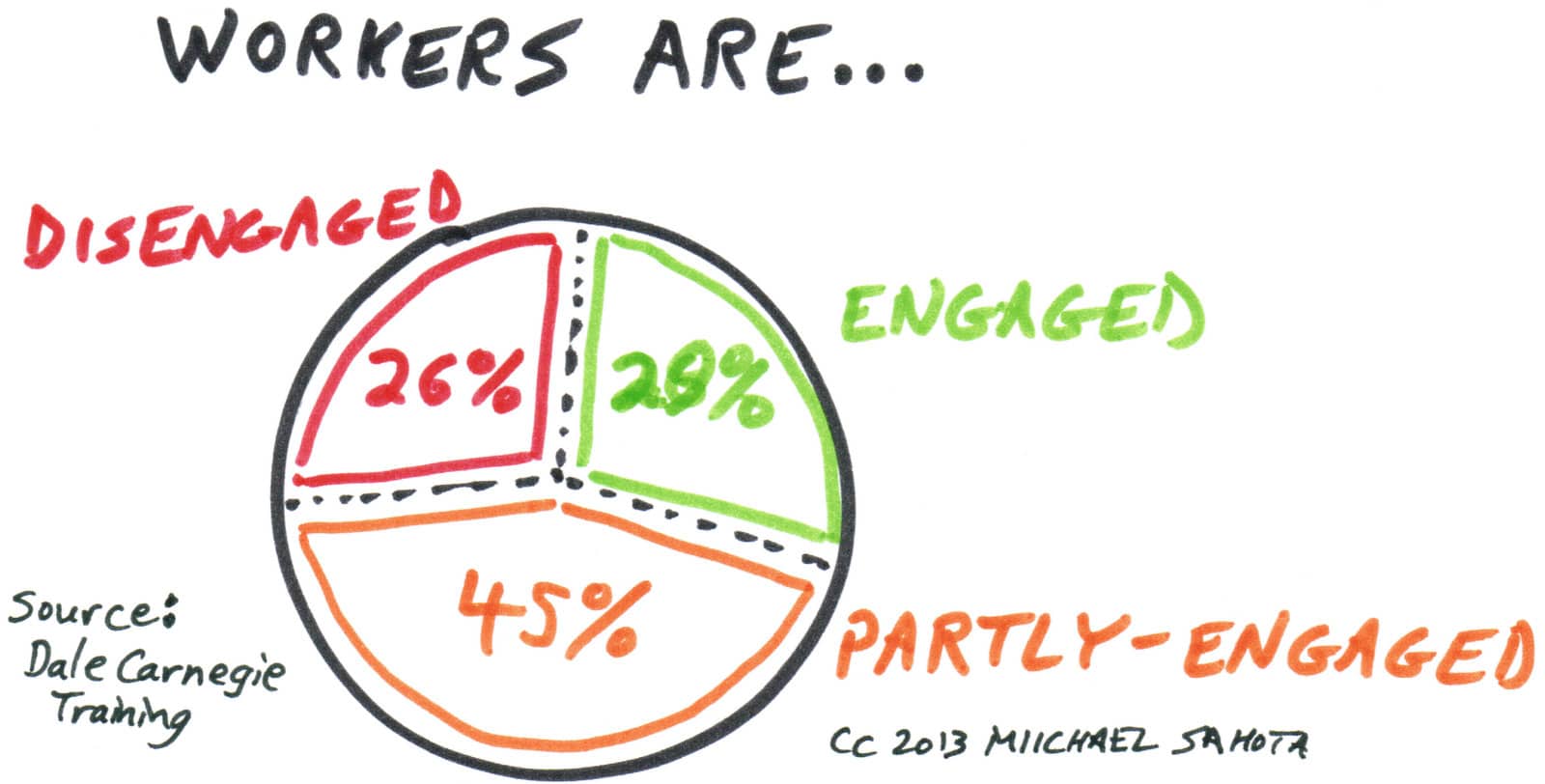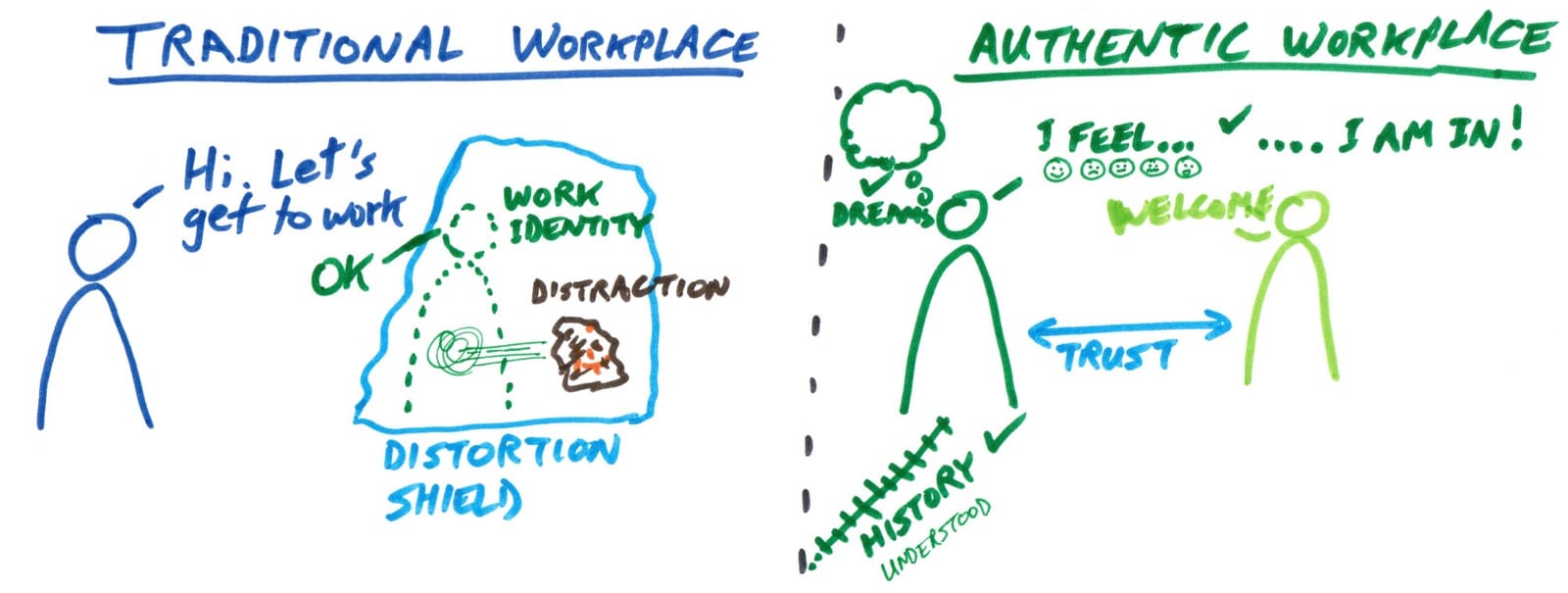People are messy: they have personalities and emotions. In this post we explore how we can embrace people’s messiness for advantage rather than have it act as a drag.
Default Business Model is Mixed Engagement
 A recent study from Carnegie Mellon Training shows that there are very mixed levels of engagement from workers. See diagram to right. Current estimates are that staff disengagement cost $11 billion from turnover alone. If we include the costs from low productivity, then $11 billion looks like pocket change. One challenge with the traditional business model is that it denies people’s individuality and feelings. People put on an “office persona” for how they think they need to be to fit in. In our workplaces, we do not dare to show our true and whole self. We do not feel welcome, and co-create work environments where sub-optimal results and shared ineffectiveness are normal.
A recent study from Carnegie Mellon Training shows that there are very mixed levels of engagement from workers. See diagram to right. Current estimates are that staff disengagement cost $11 billion from turnover alone. If we include the costs from low productivity, then $11 billion looks like pocket change. One challenge with the traditional business model is that it denies people’s individuality and feelings. People put on an “office persona” for how they think they need to be to fit in. In our workplaces, we do not dare to show our true and whole self. We do not feel welcome, and co-create work environments where sub-optimal results and shared ineffectiveness are normal.
The Authentic Workplace
An alternate model for our work environments is to invite people to show up as themselves – as the wonderful human beings that they are – and fully welcome them. We might imagine an environment that allow us to:
- Relate and connect authentically.
- Share and acknowledge feelings.
- Trust each other
- Feel safe
- Be vulnerable
Typical vs. Authentic Workplace
Consider the following diagram illustrating difference between these models:  In the traditional workplace we create a work identity that is often a shallow project of our true self. Our minds our filled with distractions from our life outside of work. We put in effort to create a distortion field around ourselves to that no one sees our true selves or our distractions.
In the traditional workplace we create a work identity that is often a shallow project of our true self. Our minds our filled with distractions from our life outside of work. We put in effort to create a distortion field around ourselves to that no one sees our true selves or our distractions.
In an authentic workplace we welcome each others dreams and ambitions, personal history and most importantly our feelings.
Authentic Workplace Benefits
Here are a few benefits:
- People are motivated when they feel valued and connected at work
- “Distractions” can be dealt with so people can focus
- Emotional support for challenges so people get unstuck
- Better decisions since people are safe to share information
Authenticity is a Spectrum
It is valuable in this discussion to keep in mind that this is not a black or white situation: traditional or authentic. We might imagine measuring or sensing the level of authenticity in a given environment. I am not thinking of metrics but guideposts such as: Do people talk about their emotions? Do people feel a sense of community and support? The 12 Questions from “First Break all the rules” can be a helpful here.
How can we develop the skills?
Below are three ways that I have been developing these skills in my own life and practice.
#1 Authentic Connection Circle – Toronto
This week I am starting an Authentic Connection Circle in Toronto as a way for people to build capacity for authentically relating to one another. We will do this by talking about the stuff that scares us to build trust and create a safe environment. Some might dismiss this as fluffy Bunny New Age. It’s not. It’s about character. Mastering out own patterns and history so that we can engage effectively with others is hard work. It takes character to be authentic and welcome what shows up in people.
#2 Temenos Workshops for Trust and Connection
Temenos is an experiential workshop that invites us to experience connection, openness and trust on a level that’s not accessible to us in daily life. With Temenos, we can safely test more effective methods of relating with others.
Temenos provides a safe setting to explore this space to develop our existing skills. We discover that we can open up to people and learn that this satisfies a deeply rooted human need.
With this experience, we may dare to treat each other more openly, truthfully, and effectively than before. We’re more aware of who we are, and what we want.
Upcoming workshops:
- Toronto – Jan 25 & 26 (Michael)
- Frankfurt – Feb. 19 & 20 (Michael/Olaf/Christine) – no website yet. Contact me if you are interested.
- Munich – Dec 12 – 14 (Olaf/Christine)
#3 Core Protocols
The Core Protocols are a set of rules designed to support high-performance teams. Some of the protocols are very supportive of building an authentic workplace. I will briefly highlight a few of them here:
- Check-in. At the start of a meeting or day everyone shares their emotional state so that there is awareness around how people are entering this context. A simple format of: I am … is used.
- Check-out. People check out when they feel they cannot focus and be productive.
- Alignment. People share what their personal development goal is and lets others know how they can help.
Leaders Go First
In “7 Habits of Highly Successful People”, Stehphen Covey talks about this as “Victory begins at home”. If you want to see these changes and benefits in your organization, you need to go first. Leadership in organizations comes from all levels. Be the change you want to see.
Acknowledgements
The primary source of this thinking for me comes from Brene Brown. Olaf Lewitz and I have been collaborating on the developing these ideas and applying them in workplaces. Parts of the text around Temenos were co-written with Olaf. Pascal Pink contributed key ideas in helping explain what Temenos really is about.


